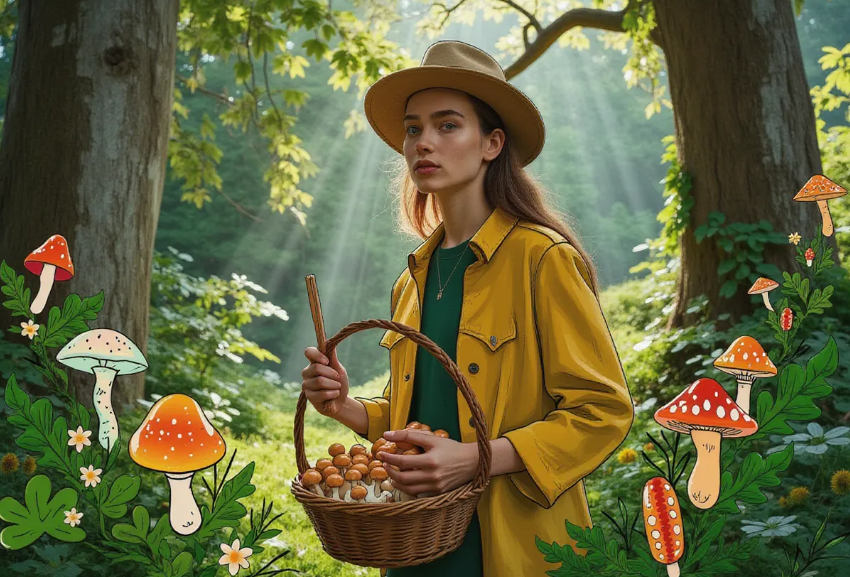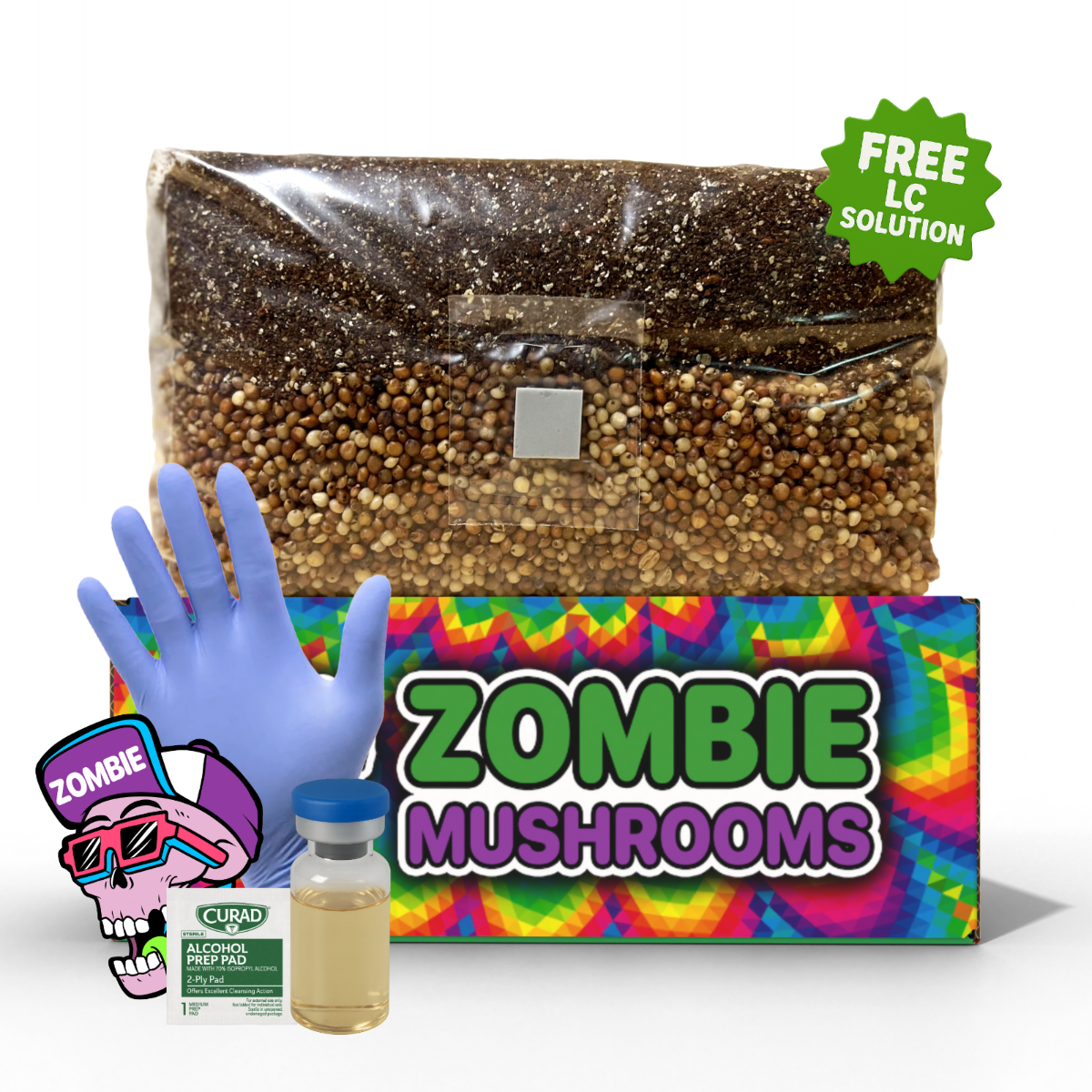⬇️ Prefer to listen instead? ⬇️
- Amanita species cause 95% of fatal mushroom poisonings in North America.
- No single field guide or app is reliable enough for safe wild mushroom identification.
- National Park Service allows up to 1 pint of mushrooms per person daily in some areas.
- Consistent overharvesting in Europe has reduced wild fungi populations.
- Cooking is essential—even edible wild mushrooms can be toxic when raw.
More people are interested in mushroom foraging because they like to cook, care about the environment, and enjoy being in nature. Looking for wild mushrooms can be exciting and feel like a healthy way to live, but you need to know about safety, rules, and how it affects nature. Some enthusiasts also explore cultivation with tools such as mushroom grow bags, which offer another approach to enjoying mushrooms. This guide looks closely at how to ID wild mushrooms, how to forage responsibly, and what the laws are, so you can be safe and know what you're doing.

What Is Mushroom Foraging?
Mushroom foraging is when you find and pick wild mushrooms to eat from places like forests, fields, and even city parks. People have been doing this for a long time all over the world—from native people in North America and Australia to people in Russia, Italy, and Japan.
Foraging helps people feel connected to nature through their senses and by learning. It’s not just about getting food. It’s also about learning about the natural systems where mushrooms grow, seeing how seasons change things, and learning about the biology of these complex things in nature. Today, mushroom foraging is becoming popular again because of food trends, permaculture, wilderness skills, and just liking nature.
Whether you like food, care about being sustainable, or are curious about science, mushroom foraging is a really involved thing to do—but there are important things to watch out for.

Is Mushroom Foraging Safe?
Nature’s Bounty Can Be Risky
The first question many new foragers ask is: "Is mushroom foraging dangerous?" It all depends on how you do it.
Wild mushroom foraging can be great, but it can also be risky. In North America, there are about 10,000 kinds of mushrooms, but only a few are good to eat. Many poisonous mushrooms look almost exactly like safe ones, and they can make you sick, cause your liver to fail, or even kill you.
For example, Amanita phalloides, called the Death Cap, looks like edible puffballs or straw mushrooms. It can kill you even if you eat a small amount. The Amanita group of mushrooms causes about 95% of deaths from mushroom poisoning in North America (Tulloss, 2020).
What Makes Foraging Risky?
- Lookalikes: Some poisonous mushrooms look almost the same as edible ones.
- Delayed Symptoms: Some poisons, like amatoxins, don’t make you feel sick until 6-12 hours later—after they have already hurt you.
- Bad Storage or Cooking: Even good mushrooms like morels can make you sick if you don’t cook them right or store them wrong.
How to Be Safe
- Never eat a mushroom if you aren't completely sure what it is.
- Check with many sources (guides, local experts, spore prints).
- Learn about poisonous mushrooms that look like edible ones.
- Be careful even with mushrooms you think are safe if you haven't eaten them before.
Basically, being safe isn't about luck—it's about learning.

Is Mushroom Foraging Legal?
Rules for Public and Private Land
Whether mushroom foraging is legal depends a lot on where you are, who owns the land, and if you want to eat the mushrooms yourself or sell them.
The National Park Service lets you pick mushrooms on some federal land, but there are strict limits—usually up to 1 pint per person each day, and only for your own use (National Park Service, 2023). Other public lands—like state parks or nature areas—might not let you forage at all, or they might require permits.
Important Legal Things to Know:
- Land Type: Rules can be very different for public parks, state lands, private forests, and city green spaces.
- Property Rights: Foraging on private land without asking is trespassing.
- Picking Limits: Many places limit how many mushrooms you can pick to prevent people from taking too many.
- Selling Rules: If you want to sell wild mushrooms you picked, you often need special papers and inspections.
Before You Go:
- Check government websites for local rules.
- Pay attention to signs and posted rules.
- Don’t think it’s okay just because other people are doing it.
Being a responsible forager means knowing the rules—and following them.

Wild Mushroom Identification: Your Most Important Safety Tool
The Key to Foraging Responsibly
The most important skill for mushroom foraging is wild mushroom identification. If you can ID mushrooms safely and correctly, you can enjoy nature’s food without getting sick—or worse.
What to Look For:
- Cap Shape and Feel: Is the top round? Scaly? Slimy?
- Gills or Pores: Look to see if the gills are attached, separate, or running down the stem.
- Stem Features: Notice how thick it is, how it feels, and if there are rings or volvas (cup-like structures at the base).
- Spore Prints: Put a mushroom cap on paper overnight to see the color of the spores—this is a very helpful way to ID mushrooms.
- Habitat Clues: Some mushrooms only grow under certain trees or in certain kinds of soil.
Tools for Identification:
- Mushroom guides made for your area.
- Apps like iNaturalist or Mushroom Observer (use them carefully).
- Learning from or working with someone from a local mushroom club.
Even with a good guide, you can still misidentify mushrooms. So, always check again—ideally with someone who knows a lot about mushrooms.

Responsible Foraging Behavior: “Don’t Harm the Mycelium”
Balance Picking with Keeping Things Safe
Most mushrooms are just the visible part of a huge underground thing called mycelium. This is a living network that breaks down dead plants, helps other plants live, and creates healthy soil systems.
If you hurt the mycelium, you’re hurting future mushrooms—and their role in keeping nature balanced.
Best Ways to Behave:
- Cut, Don't Pull: Use a knife to cut mushrooms off cleanly at the stem.
- Pick Just a Little: Only take mushrooms that are mature, and only take what you will use.
- Stay on Paths if You Can: Try not to step all over the area.
- Don’t Rake or Dig: Moving leaves around can hurt the soil and the fungi living there.
Being a good forager means leaving the area in good shape—or at least not worse than you found it.

Sustainable Foraging Methods
Think Long-Term
Mushrooms can grow back, but they aren't unlimited. Healthy ecosystems need fungi to reproduce, spread spores, and work with other living things.
To Forage Sustainably:
- Don’t Overpick in One Place: Move around to different spots so places can regrow.
- Don’t Pick Young or Rotting Mushrooms: Let them finish growing and release spores.
- Don’t Pick Rare or Endangered Mushrooms: Only pick mushrooms that are common and strong.
- Don’t Pick in Dirty Places: Mushrooms can soak up bad things like heavy metals from the environment.
In parts of Europe, picking too many mushrooms and destroying habitats has made wild fungi less common. We shouldn't do that here.

Know Your Local Environment and Seasons
Timing and Place are Key
Different mushrooms grow best in certain weather and natural conditions. Knowing this helps you ID them and find them more easily.
Best Times of Year:
- Spring: Morels, oyster mushrooms, elm mushrooms.
- Summer: Chicken of the woods, black trumpets.
- Fall (Best Time): Chanterelles, boletes, puffballs, honey mushrooms.
- After Rain: Wet conditions help mushrooms grow.
Habitat Signs:
- Deciduous trees like oak, birch, and beech are often good signs.
- Rotten logs, leaf piles, or mossy ground?
- Hillsides facing south might dry out faster; hillsides facing north hold moisture.
The more you know about your local forest, the more it will show you its hidden foods.

Tools to Bring Foraging
Be Ready, Be Safe
Your gear should help you ID, pick, and carry mushrooms safely and legally.
Gear You Need:
- Mesh or Wicker Basket: Lets spores fall out as you walk.
- Knife/Scissors: Clean cuts are better for the mycelium.
- Guidebook & App: Use both to be really sure of IDs.
- Notebook or Journal: Write down patterns, locations.
- Compass/GPS: Getting lost in the woods is not good.
- Gloves & Brush: For handling mushrooms safely and cleanly.
- Water & First Aid Kit: Basic safety for being outside.
Each tool helps you have a good—and sustainable—trip.

Safety Rules Before Eating Any Wild Mushroom
Even when you're sure a mushroom is safe to eat, be careful when you eat it for the first time.
Safety Steps:
- Always Cook Wild Mushrooms: Cooking breaks down mild poisons and makes them easier to digest.
- Try a Little Bit First: New mushrooms can cause allergies or make you feel sick.
- Don’t Pick Near Roads/Factories: Mushrooms soak up pollution and heavy metals.
- Clean Well: Dirt and bugs are common on mushrooms.
Remember: “If you’re not sure, don’t eat it.” It’s not worth risking your health on a mushroom you aren’t sure about.
Don’t Forget the Legal and Ethical Checks
Make sure your trip respects nature and the law.
Ethical & Legal Foraging Checklist:
- Got permission from the landowner (if it’s private land)?
- Checked park or local rules?
- Have permits, if needed?
- Not picking rare or at-risk mushrooms?
- Staying within picking limits?
Trust and access are important for people to enjoy foraging in the future. Good foraging habits help keep wild places open to everyone.
A Forager’s Mushroom Checklist
Use this step-by-step system to check mushrooms:
- Visual Things: Cap, gills, stem, color, smell, bruising.
- Ecology: Nearby trees, soil wetness, shade.
- Spore Print: White, brown, pink, or green?
- Check Again: Use at least two good guides.
- Write it Down: Take pictures and notes, especially if you aren't sure.
- Impact: Did you disturb the area? Did it recover quickly?
- Legal: Within limits? Asked permission?
Practicing looking at mushrooms over and over makes you better and more confident.
From Forest to Farm: Try Growing Mushrooms at Home
Growing mushrooms at home lets you learn about fungi without the risks of wild foraging.
Good Things About Home Growing:
- Safe Place: No risk of misidentifying mushrooms.
- Fresh All Year: Indoor kits mean you can always have mushrooms.
- Learning: Learn about each part of a mushroom's life.
- Eco-Friendly: Less travel—better for the environment.
Brands like Zombie Mushrooms have easy kits for beginners for mushrooms like lion's mane, oyster, and shiitake. If you like wild mushrooms but are nervous about eating them, growing them at home is a great way to start.

Mushroom Foraging as a Way to Learn About Fungi
Become more than just someone who picks mushrooms—become someone who cares for fungal systems. Every time you go out, you get better at telling mushrooms apart, watching forest health, and adding information to science projects.
Learning about fungi is partly doing fieldwork and partly a way of thinking. You'll start to see mushrooms not just as things, but as connected living things that are important underground. Understanding leads to respect—which is important for anyone who wants to walk in the forest as more than just a visitor.
Enjoy the Adventure, But Always Respect the Forest
Mushroom foraging has many good things—from food to learning—but only if you do it the right way. If you pay attention to safety, rules, and nature, mushroom foraging is more than just a hobby—it's a way to reconnect with nature.
Before you go on your next trip, or if you want a good way to begin, think about a home mushroom kit from Zombie Mushrooms. It’s a simple way to get into the world of fungi without making mistakes early on.
Happy hunting—and forage carefully.
References
- Barron, G., & Lickey, E. (2021). Mushrooms of Northeast North America. Lone Pine Publishing.
- Tulloss, R.E. (2020). Amanita studies: What's safe and what's deadly. MycoKey Publications.
- National Park Service. (2023). Foraging and Plant Collecting on Federal Lands.



